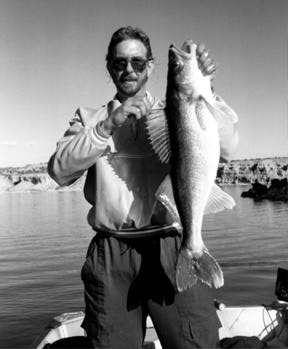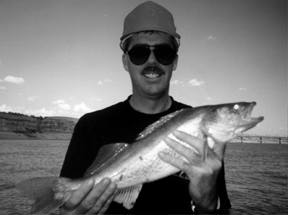|
|
Walleye Facts
See Also Bottom Bouncing For Walleye
 Walleye are one of the most
popular game-fish in the nation. Their original range was across Canada and then in a
triangular shape southward with the point of the triangle terminating in Alabama. Over the
last hundred years walleye have been planted into almost every state.
Walleye are one of the most
popular game-fish in the nation. Their original range was across Canada and then in a
triangular shape southward with the point of the triangle terminating in Alabama. Over the
last hundred years walleye have been planted into almost every state.
In Canada walleye are called pickerel, jackfish or dore´ while in the U.S. they are commonly called walleyed pike.
Walleye are closely related to saugers and belong to the perch family. They are not related to pike.
Walleye are extremely unpredictable, are constantly on the move and will bite like mad one day then disappear for a week for no apparent reason. And, when they decide to quit biting, almost nothing will change their minds.
Walleye have big marble-like eyes which have a layer of reflective pigment in the retina. This gives walleye a built in advantage — they can see well in dim light — but their most common prey, yellow perch, can not. This highly developed night vision allows walleye to do most of their feeding at night.
Because walleye eyes are so sensitive to light, they can’t tolerate bright sunlight. If the water is clear and there is no shade in the shallows, walleye will go as deep as 40 feet to escape the penetrating rays of the sun.
Walleye can see color but lack the blue-yellow cells. So walleye most likely see everything as some shade of red or green. This means that walleye can generally see red, orange and green lures better than other colors. However, the angler must remember that water color and depth change the way a lure appears to the fish. So, the best colors may change from one body of water to another or from one depth to another within the same body of water.
Walleye have an extremely sensitive lateral line system that allows them to detect minute vibrations in the water. This allows them to single out an erratically swimming bait fish or wobbling lure even in deep or murky water. This, in conjunction with their excellent eye site gives walleye a tremendous competitive advantage.
 Walleye have excellent hearing and
when in shallow water a noisy boat will put them down. Avoid trolling over them,
especially with a gas motor and don’t drop anything that will cause noise as it
bounces off the bottom of the boat.
Walleye have excellent hearing and
when in shallow water a noisy boat will put them down. Avoid trolling over them,
especially with a gas motor and don’t drop anything that will cause noise as it
bounces off the bottom of the boat.
If the water is clear and walleye are in the shallows(10 feet or less) it is generally better to drift or anchor and to cast into the shallows.
While walleye do have a good sense of smell, it is not an important factor in feeding behavior. In murky water a vibrating bait is much more effective than a bait that emits odors.
Walleye are opportunistic feeders and will eat just about any fish they can catch. Throughout much of the U.S. perch is their main food but they will also eat shad, trout, crappie, bluegill and other fish. They will also readily eat crayfish, frogs, leeches, snails, mice and even small ducks.
Fishing success for walleye is highly dependent upon the bait fish spawn. In the spring when few baitfish are present fishing is generally good (except during the spawn, when walleye don’t feed much). If the bait fish have a good spawn then by early summer there will be an abundance of small fish for the walleye to feed on.
When baitfish are plentiful fishing success for walleye slows and will remain slow until the baitfish numbers are reduced, generally by late summer or early fall. If the baitfish spawn is poor, walleye success will remain good throughout the summer and will be excellent by fall.
The old wives tale that walleye don’t feed during the summer is false. Walleye are most active during the summer and feed heavily. There is generally such an abundance of food that the chance a walleye will hit your bait or lure is reduced. Still, the knowledgeable angler will catch some nice fish.
Walleye have been known to live as long as 26 years in cold northern waters although a walleye over 15 years old is rare. How fast a walleye grows and how big it becomes is largely dependent upon the availability of food and the length of the growing season. In Canadian waters where there is a very short growing season and not much food a seven-year-old walleye may only weigh about two pounds. That same fish in a southern lake, with an eight or nine month growing season and abundant food, may grow to 15 pounds in that same seven year period.
Walleye in Utah grow well, especially when their food supply is abundant and fish up to 15 pounds are not unheard of.
Female walleye grow faster, live longer and become much larger than males. In most waters males exceeding four pounds are rare.
Walleye are a cool water fish that prefer intermediate temperatures from 65 degrees to 75 degrees. Walleye don’t like water above 80 degrees, however they will remain active in water with temperatures in the high 30s. Walleye remain active all winter long and can be caught through the ice.
Walleye prefer water that isn’t too clear. They seek out mudlines and water with lots of suspended silt or algae. In clear lakes walleye seek out turbid zones near river mouths and areas where the wind keeps the water stirred up.
Given a choice, walleye prefer clean, hard, rocky or gravelly bottoms over bottoms of silt, muck or other soft material. Walleye will be most abundant in transitional environments between sand, gravel and/or rocks.
Walleye seek out rocky, shallow shorelines and reefs to spawn. The eggs are broadcast and fall between crevices in the rocks where they are protected. Some wave action is necessary to prevent the eggs from being covered with silt and to keep them aerated.
In Utah, walleye spawn shortly after ice out and when the water temperature approaches 44 degrees. They seek out gravel areas in as little as two feet of water. The males move into the spawning areas first but they are not territorial and they do not build nests. A big female can produce almost 400,000 eggs but average production is about 50,000 eggs.
Walleyes remain in deeper water until spawning time approaches. A week or two before the spawn starts they begin to move into shallow water and to feed heavily. They will move into the spawning areas after dark and then drop back into deeper water just before sunrise.
The spawning period generally lasts from one to two weeks but if the water warms rapidly, spawning can be completed in just a few days. A severe cold snap my interrupt spawning activity for several days. If there are repeated cold periods during the spawn, the females may reabsorb their eggs and not spawn at all.
An individual female usually drops all of her eggs on the same night but all walleye do not ripen at the same time and it is common for some walleye to just begin to spawn while others have been finished for a week or more.
After spawning the males stay near the spawning area for up to a month and begin to feed heavily. Female generally move out of the spawning area and do not feed for up to two weeks.
After a couple of weeks the big females begin to feed heavily and anglers who understand this cycle can get into some of the best fishing of the year.
Walleye are oxygen sensitive and avoid water with dissolved oxygen content below 4 ppm. They don’t seek out areas with higher oxygen levels. While it is true that windswept portions of lakes attract more walleye, they are there because of the abundance of food, not because the oxygen level is higher.
Given a choice, walleye seek out areas with slight to moderate currents rather than stay in slack water. Walleye seek out currents from inlet streams, narrows separating two basins or areas with wind-induced currents.
There are several things to look for when trying to figure out where walleye are in any body of water. Walleye look for anything different from their normal surroundings. If the bottom of a reservoir is mostly mud, walleye will look for sandy areas. If most of the lake is rocks, walleye will look for sandy areas. The transition zones between mud and sand or mud and rocks, etc. will hold the most fish.
Walleye will pick a particular depth and then follow it around the reservoir. They almost never cross wide expanses of deep water to reach a new area. More likely, they will follow a contour (particular depth) around the reservoir and over time will develop preferred migration routes.
Early in the year walleye prefer gradually sloping areas near or in shallow bays where the water is warmest. However by summer, when the temperatures of the bays become too hot, the walleye will move into areas with steeper slopes and sharp breaks into deep water.
In shallow reservoirs (like Willard Bay) walleye relate to subtile depth changes. A sunken island that rises only two feet above the bottom will attract large numbers of fish. Old road beds, gravel pits, ditches, changes in the size of gravel or rocks, slope breaks, etc. will become focal points for most of the walleye in the reservoir.
In most of the country live bait is the preferred choice for walleye. Several surveys show that live bait accounts of at least two thirds of all walleye caught in a given year.
The best live baits for walleye include minnows (not legal in Utah), nightcrawlers and leeches. Night-crawlers are the most common walleye bait and are fished a variety of ways, however the most popular way is attached to a spinner rig (worm harness).
Minnow imitating lures are also a good choice but it is important to match the color and size to the natural baitfish in the water. Minnow imitating plugs with long, slender bodies and paint to resemble shad, perch or bluegill are very effective. Neutrally buoyant models are popular because they can be retrieved very slowly without floating to the surface of sinking deeper than you want them to go.
Plastic singletail or doubletail grubs, tubes, plastic shad; and marabou, bucktail and feather jigs will all take walleye if fished slowly and within the walleye’s feeding zone.